Physical-Layer Security
From Information Theory to Security Engineering
This complete guide to physical-layer security presents the theoretical foundations, prac-
tical implementation, challenges, and benefits of a groundbreaking new model for secure
communication. Using a bottom-up approach from the link level all the way to end-to-
end architectures, it provides essential practical tools that enable graduate students,
industry professionals, and researchers to build more secure systems by exploiting the
noise inherent to communication channels.
The book begins with a self-contained explanation of the information-theoretic limits
of secure communications at the physical layer. It then goes on to develop practical
coding schemes, building on the theoretical insights and enabling readers to understand
the challenges and opportunities related to the design of physical-layer security schemes.
Finally, applications to multi-user communications and network coding are also included.
Matthieu Bloch is an Assistant Professor in the School of Electrical Engineering of
the Georgia Institute of Technology. He received a Ph.D. in Engineering Science from
the Universit´e de Franche-Comt´e, Besanc¸on, France, in 2006, and a Ph.D. in Electrical
Engineering from the Georgia Institute of Technology in 2008. His research interests are
in the areas of information theory, error-control coding, wireless communications, and
quantum cryptography.
Jo ˜ao Barros is an Associate Professor in the Department of Electrical and Computer
Engineering of the Faculdade de Engenharia da Universidade do Porto, the Head of
the Porto Delegation of the Instituto de Telecomunicac¸ ˜oes, Portugal, and a Visiting
Professor at the Massachusetts Institute of Technology. He received his Ph.D. in Electrical
Engineering and Information Technology from the Technische Universit¨at M¨unchen
(TUM), Germany, in 2004 and has since published extensively in the general areas of
information theory, communication networks, and security. He has taught short courses
and tutorials at various institutions and received a Best Teaching Award from the Bavarian
State Ministry of Sciences and the Arts, as well as the 2010 IEEE ComSoc Young
Researcher Award for Europe, the Middle East, and Africa.
�
�
Physical-Layer Security
From Information Theory to Security Engineering
MATTHIEU BLOCH
Georgia Institute of Technology
JO ˜AO BARROS
University of Porto
�
CAMBRIDGE UNIVERSITY PRESS
Cambridge, New York, Melbourne, Madrid, Cape Town,
Singapore, S˜ao Paulo, Delhi, Tokyo, Mexico City
Cambridge University Press
The Edinburgh Building, Cambridge CB2 8RU, UK
Published in the United States of America by Cambridge University Press, New York
www.cambridge.org
Information on this title: www.cambridge.org/9780521516501
C Cambridge University Press 2011
This publication is in copyright. Subject to statutory exception
and to the provisions of relevant collective licensing agreements,
no reproduction of any part may take place without the written
permission of Cambridge University Press.
First published 2011
Printed in the United Kingdom at the University Press, Cambridge
A catalog record for this publication is available from the British Library
ISBN 978-0-521-51650-1 Hardback
Cambridge University Press has no responsibility for the persistence or
accuracy of URLs for external or third-party internet websites referred to
in this publication, and does not guarantee that any content on such
websites is, or will remain, accurate or appropriate.
�
To our families
�
�
Contents
Preface
Notation
List of abbreviations
Part I Preliminaries
1
An information-theoretic approach to physical-layer security
1.1 Shannon’s perfect secrecy
1.2 Secure communication over noisy channels
1.3 Channel coding for secrecy
1.4 Secret-key agreement from noisy observations
1.5 Active attacks
1.6 Physical-layer security and classical cryptography
1.7 Outline of the rest of the book
2
Fundamentals of information theory
2.1 Mathematical tools of information theory
2.1.1 Useful bounds
2.1.2 Entropy and mutual information
2.1.3 Strongly typical sequences
2.1.4 Weakly typical sequences
2.1.5 Markov chains and functional dependence graphs
2.2 The point-to-point communication problem
2.2.1 Point-to-point communication model
2.2.2 The source coding theorem
2.2.3 The channel coding theorem
2.3 Network information theory
2.3.1 Distributed source coding
2.3.2 The multiple-access channel
2.3.3 The broadcast channel
2.4 Bibliographical notes
page xi
xiii
xv
1
3
4
6
7
8
9
10
11
13
13
13
14
18
21
22
23
24
26
29
32
33
37
40
44
�
viii
Contents
Part II Information-theoretic security
3
Secrecy capacity
3.1 Shannon’s cipher system
3.2 Secure communication over a noisy channel
3.3 Perfect, weak, and strong secrecy
3.4 Wyner’s wiretap channel
3.4.1 Achievability proof for the degraded wiretap channel
3.4.2 Converse proof for the degraded wiretap channel
3.5 Broadcast channel with confidential messages
3.5.1 Channel comparison
3.5.2 Achievability proof for the broadcast channel with confidential
messages
3.5.3 Converse proof for the broadcast channel with confidential
messages
3.6 Multiplexing and feedback
3.6.1 Multiplexing secure and non-secure messages
3.6.2 Feedback and secrecy
3.7 Conclusions and lessons learned
3.8 Bibliographical notes
4
Secret-key capacity
4.1 Source and channel models for secret-key agreement
4.2 Secret-key capacity of the source model
4.2.1 Secret-key distillation based on wiretap codes
4.2.2 Secret-key distillation based on Slepian–Wolf codes
4.2.3 Upper bound for secret-key capacity
4.2.4 Alternative upper bounds for secret-key capacity
4.3 Sequential key distillation for the source model
4.3.1 Advantage distillation
4.3.2 Information reconciliation
4.3.3 Privacy amplification
4.4 Secret-key capacity of the channel model
4.5 Strong secrecy from weak secrecy
4.6 Conclusions and lessons learned
4.7 Appendix
4.8 Bibliographical notes
5
Security limits of Gaussian and wireless channels
5.1 Gaussian channels and sources
5.1.1 Gaussian broadcast channel with confidential messages
5.1.2 Multiple-input multiple-output Gaussian wiretap channel
5.1.3 Gaussian source model
47
49
49
53
55
58
65
76
78
83
90
98
103
103
104
108
110
112
113
118
120
121
127
129
134
136
143
148
162
166
169
170
174
177
177
177
185
190
�
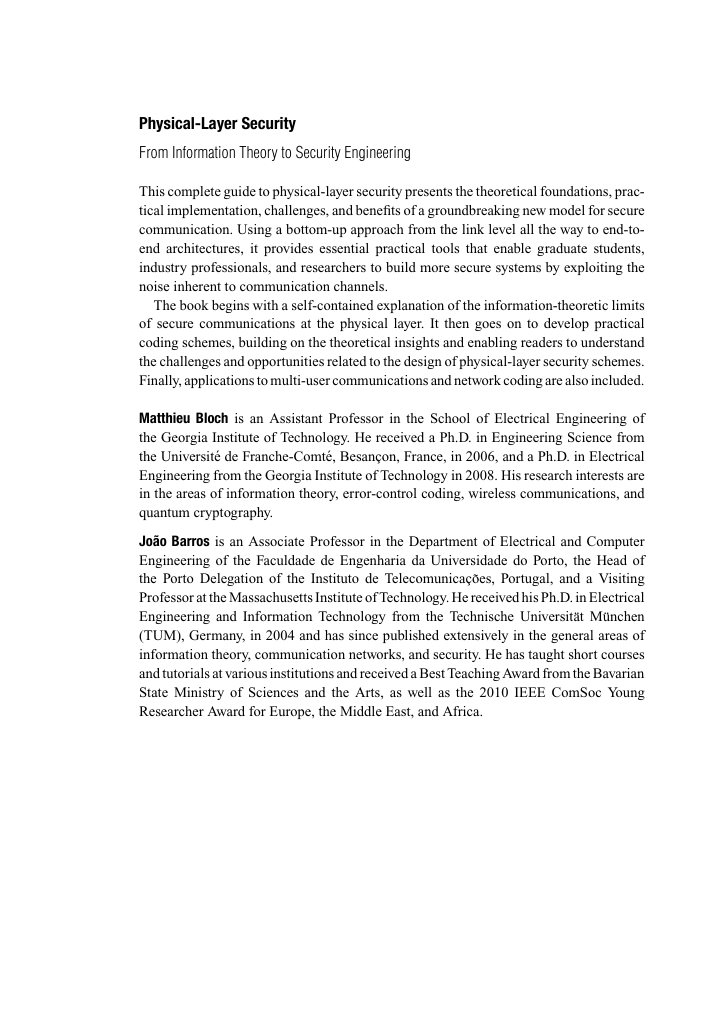

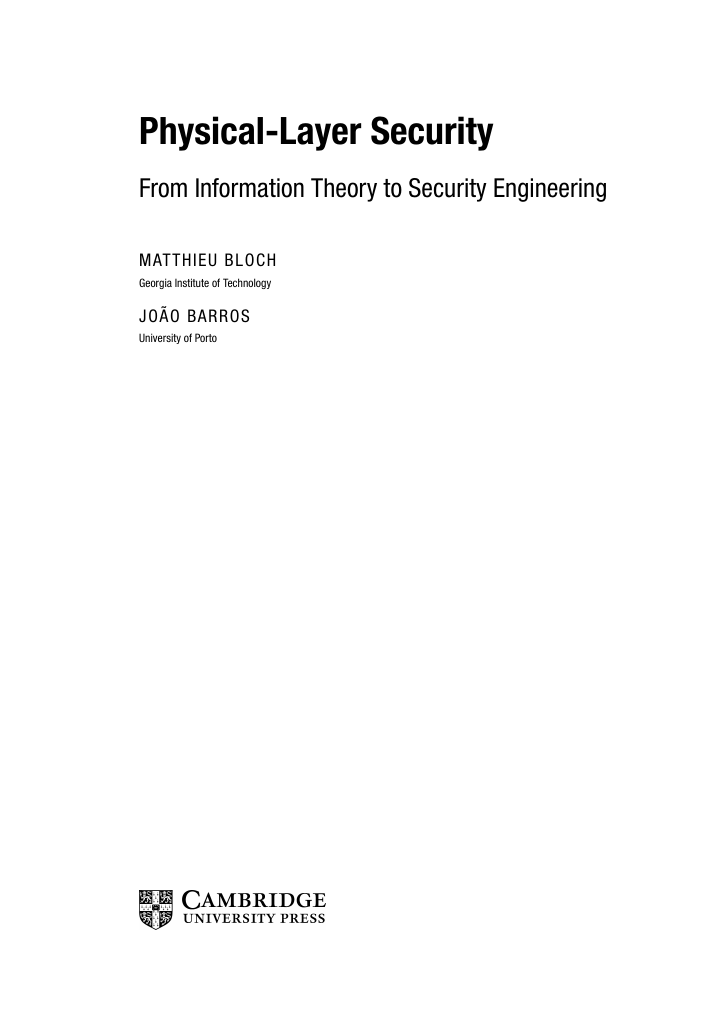
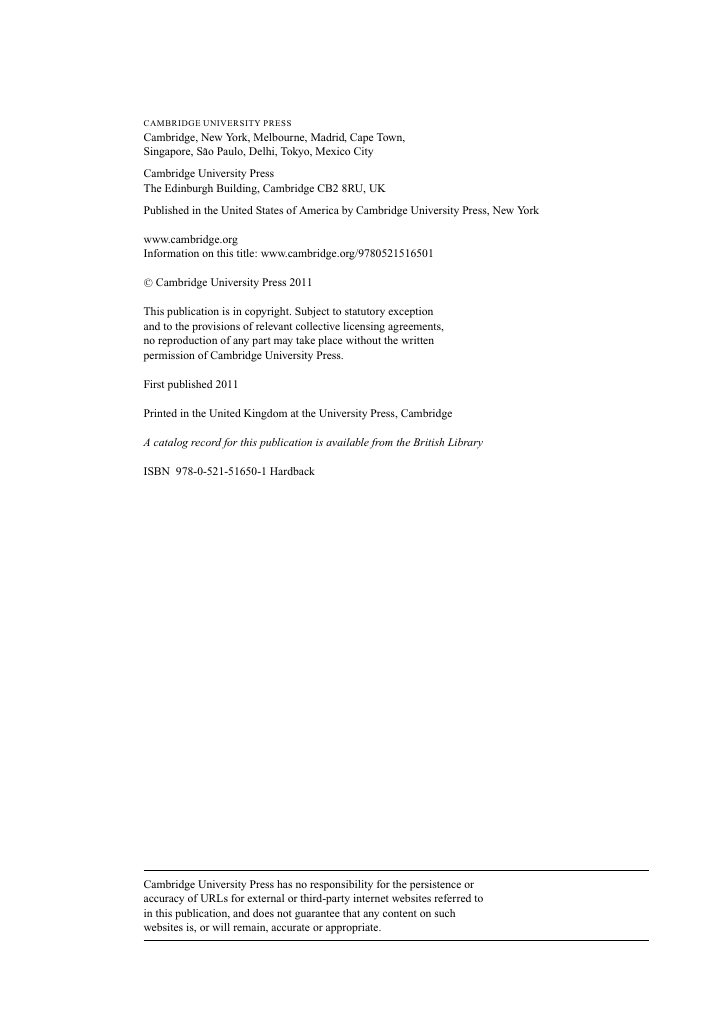


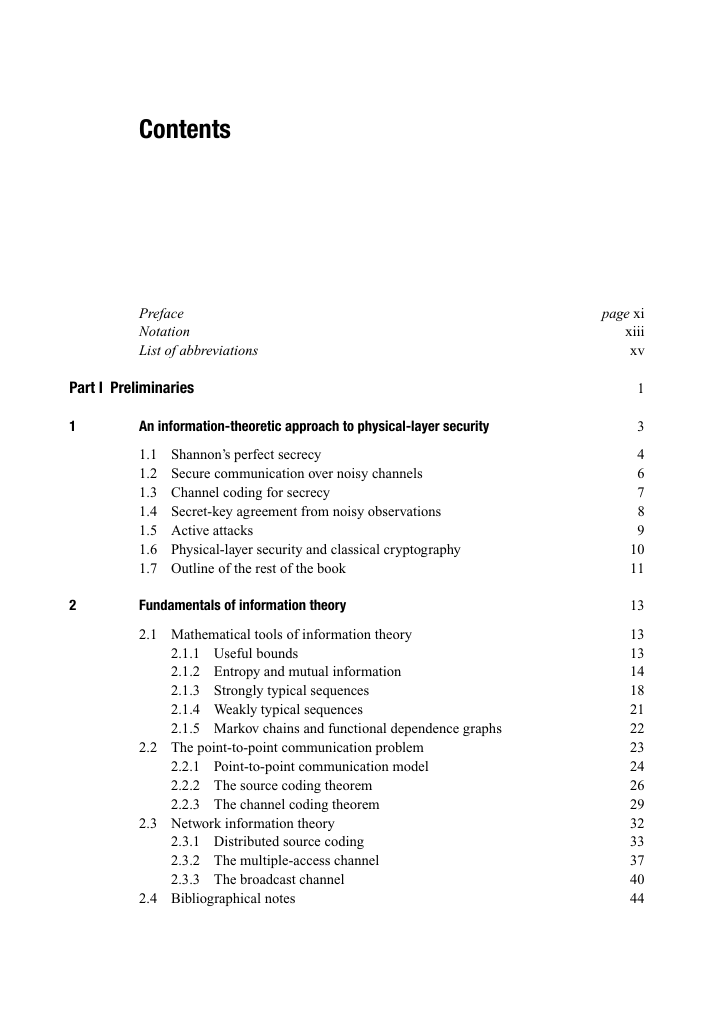
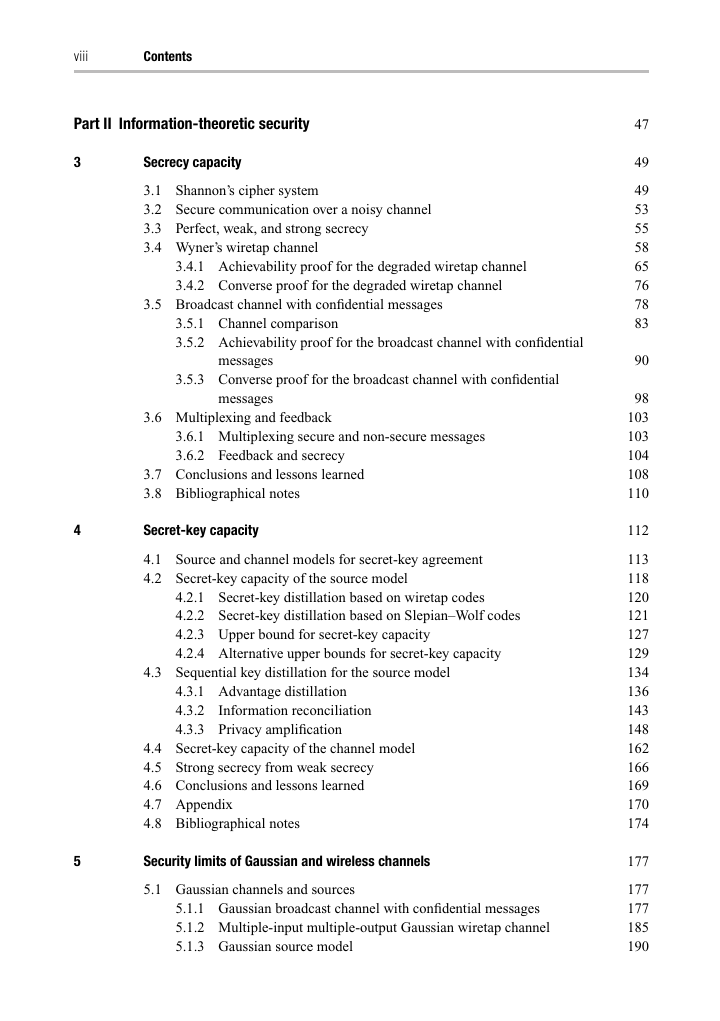








 2023年江西萍乡中考道德与法治真题及答案.doc
2023年江西萍乡中考道德与法治真题及答案.doc 2012年重庆南川中考生物真题及答案.doc
2012年重庆南川中考生物真题及答案.doc 2013年江西师范大学地理学综合及文艺理论基础考研真题.doc
2013年江西师范大学地理学综合及文艺理论基础考研真题.doc 2020年四川甘孜小升初语文真题及答案I卷.doc
2020年四川甘孜小升初语文真题及答案I卷.doc 2020年注册岩土工程师专业基础考试真题及答案.doc
2020年注册岩土工程师专业基础考试真题及答案.doc 2023-2024学年福建省厦门市九年级上学期数学月考试题及答案.doc
2023-2024学年福建省厦门市九年级上学期数学月考试题及答案.doc 2021-2022学年辽宁省沈阳市大东区九年级上学期语文期末试题及答案.doc
2021-2022学年辽宁省沈阳市大东区九年级上学期语文期末试题及答案.doc 2022-2023学年北京东城区初三第一学期物理期末试卷及答案.doc
2022-2023学年北京东城区初三第一学期物理期末试卷及答案.doc 2018上半年江西教师资格初中地理学科知识与教学能力真题及答案.doc
2018上半年江西教师资格初中地理学科知识与教学能力真题及答案.doc 2012年河北国家公务员申论考试真题及答案-省级.doc
2012年河北国家公务员申论考试真题及答案-省级.doc 2020-2021学年江苏省扬州市江都区邵樊片九年级上学期数学第一次质量检测试题及答案.doc
2020-2021学年江苏省扬州市江都区邵樊片九年级上学期数学第一次质量检测试题及答案.doc 2022下半年黑龙江教师资格证中学综合素质真题及答案.doc
2022下半年黑龙江教师资格证中学综合素质真题及答案.doc